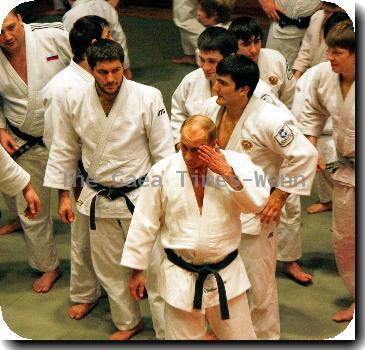Putin visits Russian village destroyed by forest fires, death toll from blazes up to 25
By Mansur Mirovalev, APFriday, July 30, 2010
25 dead as forest fires rage across Russia
MOSCOW — Forest fires raged across Russia on Friday, destroying villages, surrounding one southern city and killing at least 25 people, including three firefighters. Prime Minister Vladimir Putin consoled survivors at one smoldering village and urged officials to redouble their efforts against the blazes.
The fires have spread quickly across more than 200,000 acres (90,000 hectares) in recent days after a record heat wave and severe drought. July has been the hottest month in Moscow in 130 years of recorded history. Fields and forests have dried up, and much of this year’s wheat harvest has been ruined.
Putin on Friday visited the ruins of Verkhnyaya Vereya, where all 341 houses were burned to the ground and five residents died in the blaze. The village was one of three destroyed around Nizhny Novgorod, Russia’s fifth-largest city located 300 miles (475 kilometers) east of Moscow.
“Before winter, each house will be restored,” Putin told a crowd of distressed villagers, most of them women. “I promise — the village will be rebuilt.”
One weeping woman thanked him for his “serious talk” and promises of compensation of 200,000 rubles ($6,500) for each villager, and Putin kissed her on the cheek.
Fires have all but encircled Voronezh, a city of 850,000 people, some 300 miles (475 kilometers) south of Moscow. The streets of Voronezh were filled with smog Friday and a giant wall of rising black smoke could be seen on the horizon, television footage showed.
More than 900 patients had to be hurriedly transferred out of a Voronezh hospital and nearly 2,000 children were evacuated from 12 summer camps in the path of the flames. Firefighters were pouring water on the forests from the air, emergencies services spokeswoman Olga Izvekova said.
At least 25 people have died in the past two days from the forest fires, officials say. Fires in the Voronezh, Nizhny Novogorod and Moscow regions alone have destroyed more than 1,000 houses and left more than 2,000 people homeless, according to the country’s Emergencies Ministry. Fires also were raging in 11 other regions in central and southern Russia.
The death toll includes five people, including one firefighter, in Voronezh, and six residents and a firefighter who died when a fire swept through the Mokhovoye village in the Moscow region. The other deaths were in the Nizhny Novgorod, Ryazan and Lipetsk regions, all south or east of Moscow.
On his tour Friday, Putin urged local officials to step up operations to defeat the fires and asked President Dmitry Medvedev to send troops in to help with the firefighting. Television showed Putin in a birch forest calling the president on a cell phone and then switched to footage of Medvedev taking the call at the Kremlin.
Putin also said local officials who failed to stop the fires in their regions should resign and warned that prosecutors will “thoroughly investigate and evaluate each official.”
Forest fires reached Moscow’s western fringe on Thursday, but were extinguished toward nightfall. Cooler air from the west brought some respite from the heat Friday and cleared a potentially dangerous smog cloud caused by peat bogs burning east and south of the capital.
The mercury hit 100 (37.8 Celsius) in Moscow on Thursday, setting a new record.
Temperatures for July were 14 degrees (8 degrees Celsius) higher than normal, said Alexei Lyakhov, director of Moscow’s meteorological service, who said the heat appeared to be evidence of global warming.
“For the last few years the winters have been warm, so now perhaps a period of hot summers is starting,” he told The Associated Press.
No single hot spell should be seen as evidence of global warming, the gradual rise of the Earth’s average temperature over several decades. But climate experts predict that summer heat waves will become more frequent and intense as the world warms, raising the risks of crop damage, wildfires and health problems for the elderly and the sick.
Paul Della-Marta, a climate scientist working at Partner Reinsurance Company in Switzerland, said heat waves have clearly increased in temperate regions, the heavily populated areas between the polar and tropic regions.
“The evidence indicates that over the last 50 years a lot of the world’s temperate areas have had a significant increase in the frequency and intensity of heat waves,” Della-Marta said. “In the future we can expect a continuation of these trends.”
He was the lead author of a 2007 study that showed heat waves in Western Europe had doubled in frequency and nearly tripled in length since 1880.
Della-Marta said many previous hot spells, including a severe 2003 heat wave in Western Europe that killed tens of thousands of mostly elderly people, have been preceded by long periods with little rainfall.
“When soils are very dry, it sets up a climate feedback where the sun’s energy is not being used to evaporate water from the surface but its energy gets transferred to the air, making the air temperature a lot hotter,” he said.
Moscow is not well-equipped to handle heat in any case. Few Russian apartments and offices have air conditioning, and opening windows in the capital this week brought in the smoky smell of burning peat.
Dried up peat bogs are highly flammable and smolder underground, giving off dangerous fumes. Environmentalists say smog that blanketed Moscow in 2002 from burning peat killed hundreds of people.
_____
Associated Press writers Khristina Narizhnaya and Lynn Berry in Moscow and Karl Ritter in Stockholm contributed to this report.
Tags: Air Quality, Climate, Eastern Europe, Environmental Concerns, Europe, Fires, Forests, Heat Waves, Moscow, Russia, Seniors, Vladimir Putin, Western Europe


